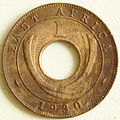First East African shilling
Unlike elsewhere in the possessions of the British Empire that used the sterling, in British East Africa the shilling instead of the pound was the primary unit of account, with the pound being a superunit mainly used for recording government and business transactions whose totals would be needlessly large if quoted solely in shillings.
This anomalous state of affairs arose because the first currency used by the British colonial authorities in British East Africa was the rupee, not sterling. The East African shilling was introduced to Kenya, Tanganyika, and Uganda in 1921, replacing the short-lived East African florin at a rate of 2 shillings to 1 florin. The florin had been introduced because of increasing silver prices after World War I. At that time, the Indian rupee was the currency of the British East African states. The rupee, being a silver coin, rose in value against sterling. When it reached the value of two shillings, the authorities decided to replace it with the florin. From the florin thence came the East African shilling. The currency remained pegged to one shilling sterling and was subdivided into 100 cents. [3] [4] [5] In 1936, Zanzibar joined the currency board, and the Zanzibari rupee was replaced at a rate of 1/50 to 1 Zanzibari rupee. [4] It was replaced by local currencies (Kenyan shilling, Ugandan shilling, and Tanzanian shilling) following the territories' independence. [3] [4] [5]
In 1951, the East African shilling replaced the Indian rupee in the Aden colony and protectorate, which became the South Arabian Federation in 1963. In 1965, the East African Currency Board was breaking up, and the South Arabian dinar replaced the shilling in the South Arabian Federation at a rate of 20 shillings to 1 dinar. [2] [6]
The shilling was also used in parts of what is now Somalia, Ethiopia, and Eritrea when they were under British control. Before 1941, these areas, then known as Italian East Africa, used the Italian East African lira. In 1941, as a result of World War II, Britain regained control and introduced the shilling, at a rate of 1 shilling to 24 Lire. Italian Somaliland was returned to Italy in 1949 as a UN Trusteeship and soon switched to the somalo, which was at par with the shilling. British Somaliland gained independence in 1960, and joined what had been Italian Somaliland to create Somalia. In that year, Somalia began using the Somali shilling (replacing the Somali somalo) at par with the East African shilling. [7]
Ethiopia regained independence in 1941, with British support, and began using the East African shilling. Maria Theresa thalers, Indian rupees, and Egyptian pounds were also legal tender at the beginning of this time, and it is unclear exactly when this status ended. Full sovereignty was restored in late 1944, and the Ethiopian dollar was reintroduced in 1945 at a rate of $1 = 2 shillings. [8] Eritrea was captured from the Italians in 1941, and began using the East African shilling, as well as the Egyptian pound. The lira was demonetised in 1942. When Eritrea formed a federation with Ethiopia in 1952, the dollar, which was already in use in Ethiopia, was also adopted in Eritrea. [9]








